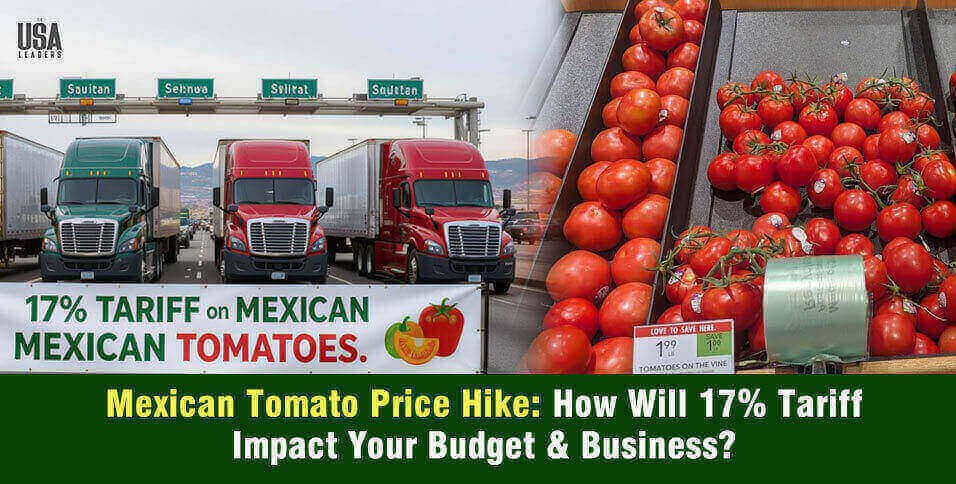The USA Leaders
August 11, 2025
Mexico – Could a tomato spark the next food price crisis in America? With Mexico setting minimum export prices for fresh tomatoes bound for the U.S., the Mexican tomato price hike is already raising alarms across grocery aisles, restaurant kitchens, and trade offices. This move comes in the wake of a bitter trade dispute—one that could soon change how much you pay for your salsa, salad, or slice of pizza.
Why Mexico Raised Prices — and How We Got Here
At the heart of the Mexican tomato price hike is a policy shift aimed at countering a 17% U.S. anti-dumping duty on Mexican tomato imports. The United States imposed this tariff after withdrawing from the 2019 Tomato Suspension Agreement, which had previously kept such trade penalties at bay.
The U.S. claims Mexican growers have been selling tomatoes at unfairly low prices, undercutting domestic producers. Mexico responded by setting minimum export prices for various tomato types, ranging from:
- Cherry, Grape, Cocktail, and Heirloom Tomatoes: $1.70/kg (a potential 26% price jump for some varieties)
- Round Tomatoes (with stems): $1.65/kg
- Round Tomatoes (standard): $0.95/kg
- Round “Bola” Tomatoes: Prices imply a jump of nearly 40%
- Roma Tomatoes: $0.88/kg.
In some cases, these new benchmarks mean price jumps of 26% to nearly 40% before the tomatoes even reach U.S. ports.
This is no small matter. Mexican tomatoes made up about 70% of the U.S. market in 2023, a dramatic increase from 30% two decades ago. In 2024 alone, the U.S. imported over 4.2 billion pounds of fresh tomatoes from Mexico—worth $3.1 billion.
How the Price Hike Will Hit U.S. Consumers
Economists estimate the new tariffs and minimum prices could push retail tomato costs up by 8 to 10%, adding around 8 cents per pound for fresh tomatoes in U.S. grocery stores.
For everyday shoppers, that may sound minor—but for low-income households, these extra cents matter, especially amid ongoing food inflation. Some regions could see steeper increases depending on local supply chains and reliance on imports.
Cherry, grape, and “bola” tomatoes are expected to see the sharpest price rises, while even staple varieties like Romas will cost more. The timing is crucial: the full impact will likely hit in the fall and winter, when U.S. domestic production dips and reliance on imports soars.
Restaurants and Small Businesses Brace for Impact
From family-owned pizzerias to high-end Mediterranean eateries, fresh tomatoes are a non-negotiable ingredient. For some, the Mexican tomato price hike could be a make-or-break moment.
“Tomatoes are in 90% of our dishes,” says Scott Nathanson, owner of Scotti’s Italian Eatery in Ohio, who has already seen cases jump from $25.20 to $30.40 since March. “You can’t just swap them out.”
Restaurateurs like Teresa Razo in Southern California fear bankruptcy if costs jump 15–20% in a matter of months. Others are trimming expenses elsewhere—cutting flowers from tables or tweaking menus—to avoid passing on the full burden to customers.
Major importers like NatureSweet warn they may raise prices by nearly 10% because their slim profit margins can’t absorb the tariffs.
Supply Chain and Market Shifts
U.S. Department of Agriculture estimates suggest Mexican tomato exports could fall 5% in 2025, tightening supply even further. Domestic producers in Florida and California might capture more market share, but experts doubt they can scale quickly enough to replace Mexico’s 90% share of U.S. tomato imports.
That gap could mean higher prices, fewer varieties, and less availability for consumers, particularly in the off-season.
Broader Economic Ripples
In 2024, Mexican tomato imports generated $8.33 billion in total economic output for the U.S., supporting nearly 47,000 jobs in sectors from transport to retail. Reduced imports risk job losses along the supply chain and dampened economic activity.
And it’s not just tomatoes. This price surge joins a broader trend of food inflation, with tariffs also hitting products like Brazilian beef and European cheese. The cumulative effect could further squeeze U.S. households already contending with rising grocery bills.
The Bottom Line
The Mexican tomato price hike isn’t just a story about trade policy—it’s about the future of food prices in America. From supermarket shelves to your local pizzeria, the fallout will be felt far beyond the produce aisle.
Unless U.S. and Mexican trade negotiators find common ground, that extra 8 cents per pound could become the new normal—and a symbol of how geopolitical disputes can trickle down to dinner plates.
Also Read: AMD & Nvidia China Chip Sales at 15% Cut: An Ideal Practice for National Security?































